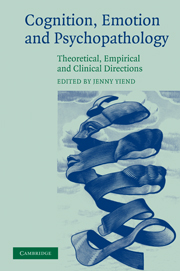Book contents
- Frontmatter
- Contents
- List of contributors
- An introduction and synthesis
- Andrew Mathews: a brief history of a clinical scientist
- Part I Theoretical approaches
- 1 The positive and negative consequences of worry in the aetiology of generalized anxiety disorder: a learning theory perspective
- 2 Trait anxiety, repressors and cognitive biases
- 3 A cognitive-motivational perspective on the processing of threat information and anxiety
- 4 Maintenance or capture of attention in anxiety-related biases?
- Part II Empirical directions
- Part III Clinical perspectives
- Index
4 - Maintenance or capture of attention in anxiety-related biases?
Published online by Cambridge University Press: 23 November 2009
- Frontmatter
- Contents
- List of contributors
- An introduction and synthesis
- Andrew Mathews: a brief history of a clinical scientist
- Part I Theoretical approaches
- 1 The positive and negative consequences of worry in the aetiology of generalized anxiety disorder: a learning theory perspective
- 2 Trait anxiety, repressors and cognitive biases
- 3 A cognitive-motivational perspective on the processing of threat information and anxiety
- 4 Maintenance or capture of attention in anxiety-related biases?
- Part II Empirical directions
- Part III Clinical perspectives
- Index
Summary
Maintenance or capture of attention in anxiety-related biases?
Anxiety is a complex experience, which serves as a biological warning system and is generally activated by the perception of danger in the environment. Normal levels of anxiety, while somewhat difficult to quantify, allow for the rapid identification of potential threat and the preparation of an appropriate response. However, anxiety levels can become abnormal when the intensity and duration of anxious episodes are disproportional to the potential for harm, or when they occur without any clear threat. In the last two decades, significant advances have been made in the understanding of how a variety of cognitive processes (e.g. attention and memory) are affected in emotional disorders. In particular, the work of Andrew Mathews and his colleagues has been influential in promoting the idea that fundamental biases in the way in which information is processed may underlie many of the characteristic problems of anxiety and depression (e.g. Mathews & Bradley, 1983; Mathews & MacLeod, 1985; Mathews, Mogg, May & Eysenck, 1989). This empirical research programme has resulted in the development of a coherent and influential framework for the understanding of emotional disorders (e.g. Mathews & MacLeod, 1994; Williams, Watts, MacLeod & Mathews, 1988, 1997). It is a great pleasure to contribute a chapter to this Festschrift for Andrew. From my very first submitted paper to Cognition and Emotion (for which Andrew was the action editor) to more recent direct collaborations, my own research and thinking have been strongly influenced by Andrew's depth of knowledge and understanding of the cognitive processes involved in emotion and emotional disorders.
- Type
- Chapter
- Information
- Cognition, Emotion and PsychopathologyTheoretical, Empirical and Clinical Directions, pp. 86 - 106Publisher: Cambridge University PressPrint publication year: 2004
- 13
- Cited by

